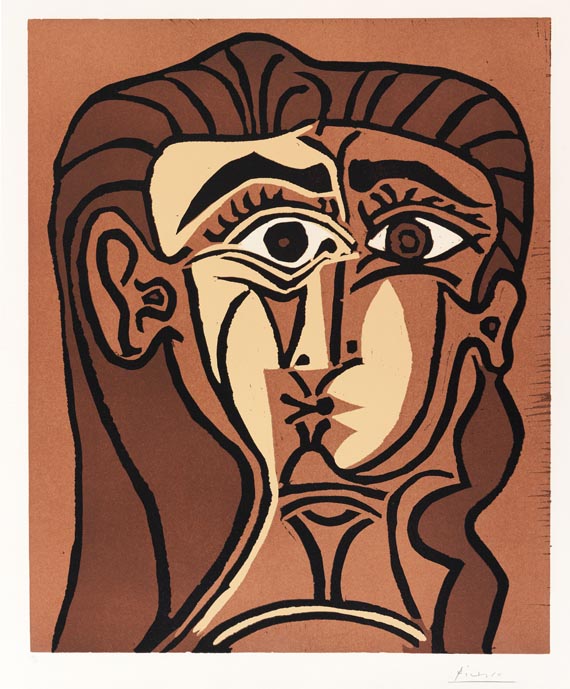
200
Pablo Picasso
Tête de Femme (Portrait de Jacqueline de face. II), 1962.
Linocut in colours
Estimate:
€ 60,000 / $ 70,800 Sold:
€ 73,200 / $ 86,376 (incl. surcharge)
Linocut in colors
Bloch 1063. Signed and numbered 21/50. On wove paper by Arches (with watermark). 64,1 x 52,7 cm (25,2 x 20,7 in)75,2 x 61,9 cm (30,6 x 25,2 in).
Printed by Arnéra, Vallauris. Released by Louise Leiris, Paris.
Picasso was introduced to art in his early childhood by his father, who was an art professor at the academy in Barcelona. Picasso's early paintings from his time in Paris were influenced by Toulouse-Lautrec, Daumier and Gauguin. An interest in Art Nouveau and Symbolism culminated in Picasso's 'Blue Period' in which he concentrated on the depiction of suffering, haggard, slightly anemic people, reflecting the fin-de-siècle mood of pessimism. Due to Picasso's contact with innovative art circles in Paris, a new and different style followed, the 'Rose Period‘. Delicate pastel colors dominate his works of this period, often depicting scenes from the world of the circus. The 'Demoiselles d'Avignon' from 1907 mark the beginning of his Cubist period in which he exceeded classical forms. The works produced between 1909 and 1912 are considered analytically Cubist, as the image‘s surface is divided into rhythmically arranged sections. As of 1912 Picasso also integrated concrete objects and began making first collages. After a realistic phase around 1915 and a beginning interest in Diaghilew's ballet in 1917, Picasso attained a Neo-classicist style. Five years later his occupation with Surrealism led to yet another new means of expression. The next turning point in Picasso's oeuvre was marked by 'Guernica', which was painted in 1937. It was commissioned for the Spanish pavilion at the World Exhibition in Paris and publicly criticized the air-raids on the Basque village of Guernica flown by the Franco-friendly German 'Legion Condor' during the Spanish Civil War.
After the World War II Picasso retreated to Southern France and began designing and painting ceramics around the middle of the 1940s. During this period he also produced most of his graphic oeuvre, drawings, lithographs, engravings and linocuts. He worked on numerous cycles in which he combined motifs from his own earlier works with historical motifs of Delacroix, Velázquez and Manet.
Picasso met Jaqueline in the summer of 1953, she soon becomes, just as all his other loves, omnipresent in his works of art. This linocut belongs to the most renown portraits of Jaqueline from the second group of large linocuts, originating
From 1962. Picasso had been working on this group in co-operation with the printer Arnéra since 1958. However, he had been occupied with this artistic technique since 1953, trying to get the most out this medium and to explore its limits with all his creative powers. In doing so he developed a new technique, inspired by the woodcuts of Munch, he managed to produce multi-color linocuts. This portrait was also made this way, employing three shades of brown and black. Picasso captured his wife’s classic beautiful face in his characteristic manner.
Picasso is considered the paragon of a modern artist who is forever in quest of new means of expression. His enormous oeuvre is full of contrasts, it broke with all academic restrictions and liberated art in the 20th century. [SM].
200
Pablo Picasso
Tête de Femme (Portrait de Jacqueline de face. II), 1962.
Linocut in colours
Estimate:
€ 60,000 / $ 70,800 Sold:
€ 73,200 / $ 86,376 (incl. surcharge)
Headquarters
Joseph-Wild-Str. 18
81829 Munich
Phone: +49 89 55 244-0
Fax: +49 89 55 244-177
info@kettererkunst.de
Louisa von Saucken / Undine Schleifer
Holstenwall 5
20355 Hamburg
Phone: +49 40 37 49 61-0
Fax: +49 40 37 49 61-66
infohamburg@kettererkunst.de
Dr. Simone Wiechers / Nane Schlage
Fasanenstr. 70
10719 Berlin
Phone: +49 30 88 67 53-63
Fax: +49 30 88 67 56-43
infoberlin@kettererkunst.de
Cordula Lichtenberg
Gertrudenstraße 24-28
50667 Cologne
Phone: +49 221 510 908-15
infokoeln@kettererkunst.de
Hessen
Rhineland-Palatinate
Miriam Heß
Phone: +49 62 21 58 80-038
Fax: +49 62 21 58 80-595
infoheidelberg@kettererkunst.de
We will inform you in time.




 Lot 200
Lot 200 